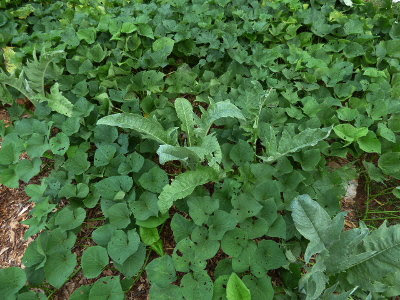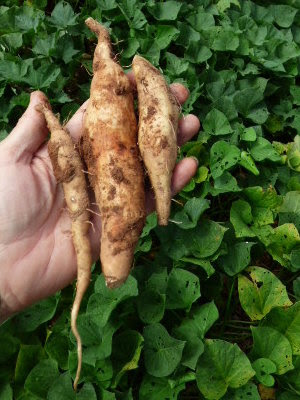Pasture improvement is one of our
homestead goals for 2018. Actually, sustainable pasture has always been a goal, but there's been a huge learning curve to go along with that goal, and so far I haven't seen the results I hoped for. In fact, I admit that this year I was discouraged because of our lack of progress in growing good forage. We seem to grow more weeds! Finally, my recent research into
carbon and soil building has given me information, answers, and the motivation I needed to tackle this year's goal with new hope.
We have five subgoals for pasture improvement:
- Build the soil.
- Establish a polyculture of predominantly perennial forage.
- Subdivide large paddocks for better grazing rotation.
- Trim low tree branches shading our pastures. (I've observed that our forage does best with filtered sunlight from a high canopy.)
- Develop a management plan to keep it in the best condition.
The first two are interdependent and since September is the month we designated for fall planting, that's what this blog post is about. I'll share more about subdividing, rotation, and our idea for a management plan in upcoming posts.
It's going to take a several weeks to get it all planted, but I thought I'd make a blog record of the first two we did, outlined in red below.
This first photo is of the "buck pasture."
It's been tilled twice in the nine
years we've lived here. The
first time was to remineralize and plant corn the other time to plant pasture. I've used my
modified Fukuoka spot seeding method here for several years, so it has some nice grasses, herbs, and clovers growing. But they are scanty, which points to problems I'm trying to correct.
The first isn't so much a problem as part of my learning curve. When I first started working on pasture improvement, the only seed available was tall fescue for winter and Bermuda for summer. Both are popular, because they tend to dominate an area to make a good monoculture pasture. But tall fescue has problems with endophytes, and Bermuda is too invasive (AKA "
wiregrass!"). So I did my first pasture planting with deer forage mixes, which are annuals.
Theoretically seasonal annuals should work if one can coordinate planting with their life cycles and so have continual forage. But somehow it never worked out that way, and every year we had long stretches with little for the goats to eat.
The other problem is weeds which tend to grow fast, shade out forage, and completely overtake grazing areas. Hopefully we can choke some of them out, but the weeds are one of the reasons I need a management plan implemented. More on that in an upcoming post.
This second photo is labeled "Front pasture" on my little map.
 |
| It's called "front" pasture because it's closest to the house. |
It's never been tilled, nor had organic minerals applied. Yet it grows more forage and has less weeds than any other place the goats graze. Like the other paddocks, I've spot seeded with manure and mulch from time to time, but it lacks forage diversity, so that's a goal here.
As with
Soil Building Experiment #1, we started with soil samples.
 |
| Buck pasture soil sample |
This one is very similar to
the samples we took near the fruit trees, isn't it? On the surface it's a little darker, but otherwise there is no organic matter and it's pretty lifeless looking. However, it contains roots! You can see them peeking out at the bottom of the sample. Roots are important for soil building, because (1) soil microorganisms need roots to live, and (2) as plants die their roots leave organic matter in the soil.
Here's the "front pasture" for comparison.
 |
| Soil sample from front pasture. |
It is darker in the top couple of inches which indicates more organic matter, but other than that, the sample doesn't look much different from the other samples we've dug. I had hoped it would look better because it's never been tilled. What that tells me, is that the soil biology on our property is severely lacking.
How do we fix that? By adding carbon. Remember my soil biology summary from
Soil Building Experiment #1?
- Soil bacteria break down compost and mulch into organic matter
- Soil fungi build organic matter into new soil
- Both feed on carbon provided by
- Conclusion: Feeding soil microorganisms = building the soil
To facilitate that, our experimental pasture planting method is no soil preparation, just broadcast the seed, then mow. The clippings mulch the seed, providing protection
and carbon.
My seed mix has been the most diverse I could manage, a combination of both perennials and annuals: wheat, oats, winter peas, perennial rye, hairy vetch, chicory, radish (both garden and Daikon), turnip, timothy, orchardgrass, non-endophyte fescue, alfalfa, birdsfoot trefoil, rape, small burnet, sanfoin, kale, buckwheat, phacelia, sorghum-sudangrass, and a variety of clovers (red, crimson, sweet, and several kinds of white). In all of that, growing conditions should be right for at least some of it to grow!
So that's the plan. We'll plant the other pastures the same way. We've had nice rainfall so these first two are just starting to show new growth. Hopefully I'll have nice forage photos to show you soon.
Next -
Developing a Pasture Rotation Plan, Part 1
















































